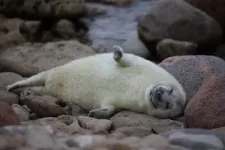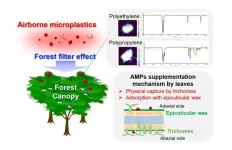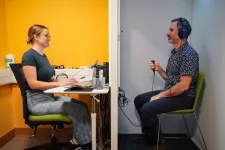Spot-on laser treatment for skin blemishes becoming clearer with new index
Numerical basis found for picosecond laser endpoints in effective clinical treatments with fewer complications
2024-03-27
(Press-News.org)
Many people bothered by skin blemishes might turn to laser treatment. To improve efficacy and reduce complications from such laser treatment, an Osaka Metropolitan University-led research group has developed an index of the threshold energy density, known as fluence, and the dependent wavelength for picosecond lasers.
Picosecond lasers have in recent years been used to remove pigmented lesions. These lasers deliver energy beams in pulses that last for about a trillionth of a second. The lasers target melanosomes, which produce, store, and transport the melanin responsible for pigment.
Postdoctoral Fellow Yu Shimojo of OMU’s Graduate School of Medicine and Specially Appointed Professor Toshiyuki Ozawa and Professor Daisuke Tsuruta of the school’s Department of Dermatology were among the researchers who developed this first picosecond laser index for each of the wavelengths used in clinical practice in treating pigmented lesions.
Comparing previously reported clinical studies, the researchers confirmed that clinical results showing low complication rates and high efficacy can be explained based on these wavelength-dependent indicators.
“The use of this indicator is expected to play an important part in setting irradiation conditions in clinical practice,” Postdoc Fellow Shimojo said. “In addition, the implementation of picosecond laser therapy based on scientific evidence, rather than relying solely on physicians’ experience, is expected to improve the safety and effectiveness of the treatment.”
The findings were published in Lasers in Surgery and Medicine.
###
About OMU
Osaka Metropolitan University is the third largest public university in Japan, formed by the merger of Osaka City University and Osaka Prefecture University in 2022. OMU upholds the “Convergence of Knowledge” through 11 undergraduate schools, a college, and 15 graduate schools. For more research news, visit https://www.omu.ac.jp/en/ and follow us on X @OsakaMetUniv_en, Instagram, and Facebook.
END
ELSE PRESS RELEASES FROM THIS DATE:
2024-03-27
Researchers at the University of Gothenburg warn that today's hunting quotas of about 3,000 animals pose a risk to the long-term survival of the grey seal in the Baltic Sea. The conclusions of this new study are based on statistics from 20th century seal hunting and predictions of future climate change.
After decades of hard hunting and environmental contamination by toxins such as PCBs, there were only 5,000 grey seals left in the entire Baltic Sea by the 1970s, falling from an initial size of more than 90,000 at the ...
2024-03-27
Australian rock-wallabies are ‘little Napoleons’ when it comes to compensating for small size, packing much more punch into their bite than larger relatives.
Researchers from Flinders University made the discovery while investigating how two dwarf species of rock-wallaby are able to feed themselves on the same kinds of foods as their much larger cousins.
Study leader Dr Rex Mitchell also coined the idea of ‘Little Wallaby Syndrome’ after examining the skulls of dwarf rock-wallabies to discover they can more than compensate for their size.
“We already knew that ...
2024-03-27
Reaching sustainability is one of humanity’s most pressing challenges today—and also one of the hardest. To minimize our impact on the environment and start reverting the damage humanity has already caused, striving to achieve carbon neutrality in as many economic activities as possible is paramount. Unfortunately, the synthesis of many important chemicals still causes high carbon emissions.
Such is the case of acetylene (C2H2), an essential hydrocarbon with a plethora of applications. This highly ...
2024-03-27
In recent years, the world has been experiencing floods and droughts as extreme rainfall events have become more frequent due to climate change. For this reason, securing stable water resources throughout the year has become a national responsibility called 'water security', and 'Aquifer Storage Recovery (ASR)', which stores water in the form of groundwater in the ground when water resources are available and withdraws it when needed, is attracting attention as an effective water resource management technique.
The Korea Institute of Science and Technology (KIST) announced that a team of Dr. Seunghak ...
2024-03-27
Researchers at Trinity College Dublin have recovered remarkably preserved microbiomes from two teeth dating back 4,000 years, found in an Irish limestone cave. Genetic analyses of these microbiomes reveal major changes in the oral microenvironment from the Bronze Age to today. The teeth both belonged to the same male individual and also provided a snapshot of his oral health.
The study, carried out in collaboration with archaeologists from the Atlantic Technological University and University ...
2024-03-27
Lung cancer is the leading cause of cancer-related death worldwide. Improved understanding of driver mutations of non-small cell lung cancer (NSCLC) has led to more biomarker-directed treatment for patients with advanced stages. The expanding number of drugs targeting these driver mutations offers more opportunity to improve patient’s survival benefit.
To date, NSCLCs, especially those with non-squamous histology, are recommended for testing epidermal growth factor receptor (EGFR) mutations, anaplastic lymphoma kinase (ALK) gene rearrangements, ROS proto-oncogene receptor tyrosine kinase 1 (ROS-1) rearrangements, B-raf proto-oncogene (BRAF) mutations, rearranged during transfection ...
2024-03-27
Rabbits are popular family pets, with around 1.5 million* in the UK and it is important that owners can recognise when their animal is in pain, and know when to seek help to protect their rabbit’s welfare. New research by the University of Bristol Veterinary School has found the majority of rabbit owners could list signs of pain and could mostly identify pain-free rabbits and those in severe pain, but many lacked knowledge of the subtler sign of pain.
The study, published in BMC Veterinary Research today [27 March], provides the first insight into how rabbit owners identify pain and their general ability to apply this knowledge to detect pain ...
2024-03-27
A research group led by Japan Women’s University finds that airborne microplastics adsorb to the epicuticular wax on the surface of forest canopy leaves, and that forests may act as terrestrial sinks for airborne microplastics
Tokyo, Japan – Think of microplastics, and you might think of the ones accumulating in the world’s oceans. However, they are also filling the sky and the air we breathe. Now, it has been discovered that forests might be acting as a sink for these airborne microplastics, offering humanity yet another ...
2024-03-27
The world-leading Dunedin Study is set to launch its age 52 assessments, delving into an understudied but important period of life and time of change.
The Dunedin Multidisciplinary Health and Development Study is a longitudinal study that follows the lives of 1037 babies born in Queen Mary Maternity Hospital between 1 April 1972 and 31 March 1973. It is the most detailed study of human health and development in the world.
Members have been assessed regularly throughout their lives, most recently at age 45.
Study Director, Research Professor Moana Theodore is incredibly excited ...
2024-03-27
An opportunistic emergency department stop smoking prompt, comprising brief advice by a trained professional, an e-cigarette starter kit, and referral to local stop smoking services can help smokers quit, with a significant proportion of them still not smoking 6 months later, finds research published online in Emergency Medicine Journal.
Some 6.4 million people in the UK still haven’t stubbed out for good, and of the large numbers of people attending emergency departments, a substantial proportion are more likely to be smokers and have poorer overall health, explain ...
LAST 30 PRESS RELEASES:
[Press-News.org] Spot-on laser treatment for skin blemishes becoming clearer with new index
Numerical basis found for picosecond laser endpoints in effective clinical treatments with fewer complications









